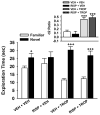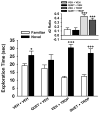Tropisetron enhances recognition memory in rats chronically treated with risperidone or quetiapine
- PMID: 29175423
- PMCID: PMC6567993
- DOI: 10.1016/j.bcp.2017.11.017
Tropisetron enhances recognition memory in rats chronically treated with risperidone or quetiapine
Abstract
While impairments of cognition in schizophrenia have the greatest impact on long-term functional outcome, the currently prescribed treatments, antipsychotic drugs (APDs), do not effectively improve cognition. Moreover, while more than 20 years have been devoted to the development of new drugs to treat cognitive deficits in schizophrenia, none have been approved to date. One area that has not been given proper attention at the preclinical or clinical stage of drug development is the chronic medication history of the test subject. Hence, very little is known about how chronic treatment with drugs that affect multiple receptors like APDs influence the response to a potential pro-cognitive agent. Therefore, the purpose of this study was to evaluate the α7 nicotinic acetylcholine receptor (α7 nAChR) partial agonist, tropisetron in rats chronically treated with APDs with distinct pharmacological profiles. Rats were treated orally with either risperidone (2.5 mg/kg/day) or quetiapine (25.0 mg/kg/day) for 30 or 90 days and then an acute injection of vehicle or tropisetron (3.0 mg/kg) was administered before training in a novel object recognition (NOR) task. After a 48 h delay (when recollection of the familiar object was impaired in vehicle-treated animals) neither 30 nor 90 days of risperidone or quetiapine treatment improved NOR performance. In contrast, tropisetron markedly improved NOR performance in rats treated with either APD for 30 or 90 days. These animal data reinforce the argument that two commonly prescribed APDs are not pro-cognitive agents and that α7 nAChR ligands like tropisetron have potential as adjunctive treatments in schizophrenia.
Keywords: Antipsychotic; Cholinergic; Cognition; Nicotinic receptor; Schizophrenia.
Copyright © 2017 Elsevier Inc. All rights reserved.
Figures





References
-
- Green MF, Kern RS, Braff DL, Mintz J. Neurocognitive deficits and functional outcome in schizophrenia: are we measuring the “right stuff”? Schizophr Bull. 2000;26(1):119–36. - PubMed
Publication types
MeSH terms
Substances
Grants and funding
LinkOut - more resources
Full Text Sources
Other Literature Sources

